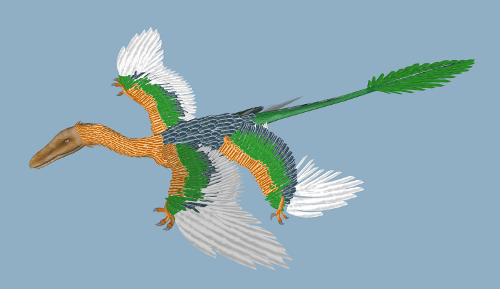
Wind Tunnel Reveals Dinosaur's Flight Secrets
Researchers at the University of Southampton have tested a model of a Microraptor (a feathered, four-winged dinosaur) in a wind tunnel and found that it was optimized for slow gliding. Its multiple wings performed the same function as a modern-day, high-lift configuration used on airliners for takeoff and landing.
 MicroraptorSketchUp Model
MicroraptorSketchUp Model
Though not efficient in terms of drag, high-lift systems are designed to produce lift at slow speeds, which would match the need for gliding by this proto-bird dinosaur.
Surprisingly, the researchers also found that the leg position and wing shape made little difference to the flight characteristics of the Microraptor. This implies that the configuration was not highly optimized, which supports the theory that feathers initially evolved independently of aerodynamic requirements.
To compliment these wind tunnel tests it would be interesting to see a Computational Fluid Dynamics (CFD) study to investigate further the complex velocity flow field around the dinosaur in flight.
Notes
- Source: University of Southampton (2013, September 18). Dinosaur wind tunnel test provides new insight into the evolution of bird flight. ScienceDaily. Retrieved September 19, 2013
- Paper: Gareth Dyke, Roeland de Kat, Colin Palmer, Jacques van der Kindere, Darren Naish & Bharathram Ganapathisubramani, Aerodynamic performance of the feathered dinosaur Microraptor and the evolution of feathered flight, Nature Communications 4, Article number: 2489, 18 September 2013
- Check out a multi-element, high-lift CFD example performed in Caedium
Recent blog posts
- CFD Simulates Distant Past
- Background on the Caedium v6.0 Release
- Long-Necked Dinosaurs Succumb To CFD
- CFD Provides Insight Into Mystery Fossils
- Wind Turbine Design According to Insects
- Runners Discover Drafting
- Wind Tunnel and CFD Reveal Best Cycling Tuck
- Active Aerodynamics on the Lamborghini Huracán Performante
- Fluidic Logic
- Stonehenge Vortex Revealed as April Fools' Day Distortion Field
